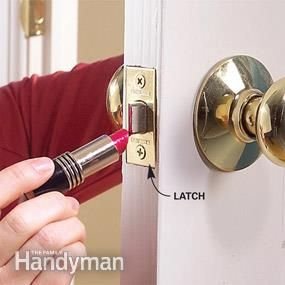
Let’s explore what makes these latches challenging and how we can troubleshoot them effectively. We’ll focus on practical solutions that won’t require a toolbox, and I’ll guide you through each step, ensuring everyone can come and go with ease. So grab a cup of coffee, and let’s dig into making your home more accessible.
Identifying the Problem: Why Door Latches Get Stuck
Before we dive into fixes, let’s understand why some door latches are harder to operate than others. Many factors can contribute to this issue. One major reason could be the type of latch itself. Some latches are designed for security and may require more force to operate, which can be difficult for small children or elders.
Wear and Tear is another big factor. Over time, door latches can accumulate dirt, rust, or even physical damage, making it tougher to turn or pull. Think of it like a rusty bike chain—it just doesn’t move as smoothly.
Temperature can also play a role. In colder months, materials can contract, making them slightly tighter. Conversely, heat may cause them to expand, resulting in a stuck latch. So, it’s important to consider when the latch seems harder to operate.
Checking the Alignment of Your Door and Latch
Sometimes, the problem lies not just with the latch but with its alignment on the door. If the latch doesn’t sit properly in the strike plate (the metal piece you see on the door frame), it can lead to issues. Here’s how to check:
1. Close the Door: Gently shut the door and look at where the latch meets the strike plate. Are they aligned?
2. Look for Gaps: If there’s a gap, or if the latch seems off-center, it might need adjusting.
3. Try to Open It: With the door closed, try operating the latch. If it feels snug, that’s your clue!
If alignment is the issue, you might need to loosen the screws from the hinge side of the door and then reposition it slightly for a better fit. This can be a simple fix but can make a world of difference for little hands or frail fingers.
Cleaning Your Door Latch: A Simple Solution
Often, a good cleaning is all a door latch needs to operate smoothly again. Dust, dirt, and even grime can build up, creating friction that makes it hard to turn. Here’s a quick way to clean it:
1. Gather Your Supplies: You’ll need a soft cloth, some warm soapy water, and a toothbrush or small brush.
2. Dampen the Cloth: Lightly wet the cloth with your soapy water.
3. Wipe Down the Latch: Gently clean the latch, taking care to get into any crevices.
4. Scrub with a Brush: Use the toothbrush to scrub any stubborn spots, especially around the mechanism.
5. Dry Thoroughly: It’s essential to dry the latch completely to avoid rust.
This little maintenance job can really help create a smoother operation, especially for those who have a tough time with stiff latches.
Lubrication: Keeping Your Latch Moving Smoothly
If cleaning doesn’t do the trick, it might be time to add some lubricant. Just like a well-oiled bike chain, a door latch benefits from a little grease. Here’s how you can do it safely:
1. Choose the Right Lubricant: Look for a silicone spray or a graphite lubricant. Avoid oil-based products as they can attract more dirt.
2. Apply Sparingly: Spray or apply a small amount directly onto the latch mechanism.
3. Work the Latch: Open and close the latch several times to distribute the lubricant. This action helps it seep into the parts that need it most.
Now, you’ve not only cleaned but also made it easier for children and the elderly to operate the door latch effortlessly.
Adjusting the Spring Tension of Your Latch
Some latches have a spring mechanism that can be adjusted. If the latch is too stiff, reducing the spring tension can make a significant difference. Here’s how to do it:
1. Locate the Adjustment Screw: Look for a small screw on the latch assembly. This is often found at the edge of the door or on the latch itself.
2. Turn the Screw: Use a screwdriver to turn the screw counterclockwise slightly. Make small adjustments and test the latch after each turn.
3. Test for Ease of Use: Ensure it’s still secure but easier to operate for those who need it.
Adjusting the spring tension can help ensure that the latch is not too hard to operate while still keeping your door securely closed.
Considering Replacement Hardware
If you find that all these troubleshooting steps haven’t made a significant difference, it might be time to consider replacing the latch or the entire door handle. There are many options available that are specifically designed to be more user-friendly for children and the elderly.
Look for latches that feature:
– Lever Handles: These are easier for small hands or those with less grip strength.
– Child Safety Locks: These keep doors secure while still being accessible.
– Ergonomic Designs: Some designs focus on comfort and ease of use.
Replacing the latch or handle may seem like a big step, but it can greatly enhance accessibility in your home.
Final Thoughts: Ensuring Safety and Accessibility at Home
A door latch that’s hard to operate can pose a challenge for anyone, especially for children or elderly family members. By understanding the common issues and knowing how to troubleshoot a door latch, you can create a more accessible environment in your home. Remember, even the smallest adjustments can make a big difference.
So, whether it’s a good cleaning, a bit of lubrication, or a complete replacement, these steps can help ensure that everyone at home can come and go without hassle. It’s all about making our spaces comfortable and safe for everyone. You’ve got this!